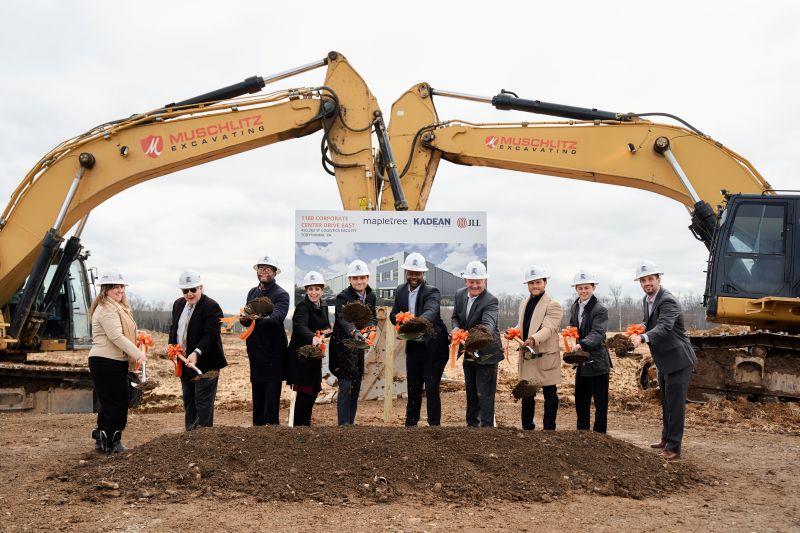Industrial Park Aims to Bring Jobs, Growth to Pearl River County – Mississippi Free Press

Report on the Pearl River County Industrial Park Development Project
Introduction: Fostering Sustainable Economic Growth
Pearl River County, Mississippi, has initiated the development of a new 130-acre industrial park aimed at transforming the regional economy. This project represents a significant, multi-generational investment aligned with several United Nations Sustainable Development Goals (SDGs), particularly SDG 8 (Decent Work and Economic Growth) and SDG 9 (Industry, Innovation, and Infrastructure). The primary objective is to create long-term, high-quality employment opportunities and establish a foundation for sustainable industrial development.
Project Details and Strategic Partnerships
Site Acquisition and Redevelopment
The county acquired a 130-acre site, formerly an abandoned wood chip mill, in May 2022. This redevelopment of a derelict property into a productive economic zone directly supports SDG 11 (Sustainable Cities and Communities) by promoting responsible land use and urban regeneration.
Funding and Collaboration (SDG 17)
The project is a model for SDG 17 (Partnerships for the Goals), leveraging a multi-stakeholder funding approach. The initial land purchase and subsequent development have been financed through a combination of sources:
- $1.6 million: Gulf Coast Restoration Fund
- $400,000: Pearl River County
- $10.6 million (total awarded): A combination of state funds, Mississippi Development Authority grants, and contributions from utility partners. Approximately 84% of this total is grant-funded.
Infrastructure Development (SDG 9)
Current construction efforts are focused on creating “site-ready” land to attract investment, a key component of SDG 9. Ongoing work includes:
- Grading, drainage, and base improvements within the park.
- Development of three “pad-ready” lots for future industrial tenants.
- Widening of Highway 26 to improve drainage and commercial truck access.
Construction is approximately 50% complete, with substantial completion anticipated by the end of 2025 and final touches extending into 2026.
Alignment with Sustainable Development Goals
SDG 8: Decent Work and Economic Growth
The industrial park is designed to be a catalyst for inclusive and sustainable economic growth by:
- Creating Higher-Paying Jobs: The project aims to attract industries that can offer wages significantly higher than the county average of $33,000, potentially raising local incomes by nearly 50% and aligning with the manufacturing sector’s average earnings of $55,000.
- Reducing Commuting Burdens: By providing local employment, the park will reduce financial and time burdens on families, improving overall quality of life.
- Retaining Local Talent: The availability of skilled jobs is expected to encourage graduates and young workers to remain in the community, reversing regional “brain drain.”
SDG 9: Industry, Innovation, and Infrastructure
The development builds resilient infrastructure and promotes sustainable industrialization through:
- Targeted Industry Recruitment: The county plans to attract industries in advanced, sustainable sectors, including aerospace, the blue economy, advanced manufacturing, polymers, distribution, and healthcare.
- Strategic Location: The park’s proximity to major interstates, highways, ports, and airports provides a logistical advantage for modern industry.
- Environmental Planning: The project incorporates a comprehensive environmental plan, including stormwater treatment and detention systems to protect downstream water quality, contributing to SDG 6 (Clean Water and Sanitation).
SDG 11: Sustainable Cities and Communities
The project enhances community sustainability by:
- Balancing the Tax Base: New industries will contribute to county revenue, reducing the financial burden on residential taxpayers.
- Improving Work Environments: Plans include the development of green spaces for employees, promoting well-being and creating an attractive work environment.
- Fostering Local Economic Circulation: Local employment keeps money circulating within the community, supporting small businesses and local services.
SDG 4: Quality Education
A crucial element of the project’s long-term success is its partnership with Pearl River Community College (PRCC), located one mile from the site. This collaboration will ensure a skilled workforce is available to meet the needs of incoming industries through on-the-job training and upskilling programs, directly supporting SDG 4.
Projected Outcomes and Timeline
Economic and Community Transformation
Officials project that the industrial park will be a transformative force for Poplarville and the surrounding region. The primary expected outcomes are the creation of stable, high-paying jobs and a diversified local economy. This will provide residents with more options for local employment, enhance community resilience, and foster regional growth.
Future Outlook
The park is expected to be fully developed and operational within five years, contingent upon the successful recruitment and relocation of industrial tenants. The strategic infrastructure, workforce development partnerships, and focus on sustainable practices position Pearl River County to become one of Mississippi’s fastest-growing regions.
Analysis of Sustainable Development Goals in the Article
1. Which SDGs are addressed or connected to the issues highlighted in the article?
-
SDG 8: Decent Work and Economic Growth
- The article’s primary focus is on the creation of an industrial park to “transform the local economy and create long-term job opportunities.” This directly aligns with SDG 8’s goal of promoting sustained, inclusive, and sustainable economic growth, full and productive employment, and decent work for all. The project aims to create “higher-paying jobs” and raise the average income, which is a core component of this goal.
-
SDG 9: Industry, Innovation and Infrastructure
- The project involves building resilient infrastructure and promoting sustainable industrialization. The article details the development of a 130-acre industrial park, including “grading, drainage and base improvements,” creating “pad-ready lots,” and “widening Highway 26 to improve drainage and truck access.” This focus on building infrastructure to attract diverse industries like “aerospace, … advanced manufacturing and healthcare” is central to SDG 9.
-
SDG 11: Sustainable Cities and Communities
- The industrial park is presented as a way to make the community more sustainable and inclusive. It aims to retain local talent (“keep our kids from leaving”), reduce long commutes, and allow residents to “live and work locally.” The project also includes environmental planning, such as “storm water treatment and detention systems,” and repurposes an abandoned industrial site, which are key aspects of sustainable urban planning. Furthermore, the goal to “balance the county’s tax base, easing the financial burden on homeowners” contributes to the financial sustainability of the community.
2. What specific targets under those SDGs can be identified based on the article’s content?
-
SDG 8: Decent Work and Economic Growth
- Target 8.2: Achieve higher levels of economic productivity through diversification and innovation. The article mentions the county’s plan to “recruit industries in aerospace, the blue economy, distribution, polymers, advanced manufacturing and healthcare,” which represents a clear strategy for economic diversification.
- Target 8.5: By 2030, achieve full and productive employment and decent work for all. The project’s stated goal is to “create long-term job opportunities” and “higher-paying jobs.” The article highlights the potential to raise the average wage from “$33,000” to closer to the manufacturing average of “$55,000,” directly addressing the creation of decent work.
-
SDG 9: Industry, Innovation and Infrastructure
- Target 9.1: Develop quality, reliable, sustainable and resilient infrastructure to support economic development. The article describes the construction of the industrial park with “pad-ready lots,” improved highway access, and available utilities as essential for attracting investors and supporting economic growth.
- Target 9.2: Promote inclusive and sustainable industrialization. The project is a significant investment in industrialization for a county that previously lacked “site-ready” land. The inclusion of environmental plans for stormwater management shows a commitment to making this industrialization sustainable.
-
SDG 11: Sustainable Cities and Communities
- Target 11.3: Enhance inclusive and sustainable urbanization and capacity for participatory, integrated and sustainable human settlement planning and management. The development of a 130-acre abandoned site into a planned industrial park is a direct example of strategic land-use planning to foster local growth.
- Target 11.6: Reduce the adverse per capita environmental impact of cities. The article explicitly mentions the “county’s environmental plan offers storm water treatment and detention systems to help filter and control before it reaches downstream water,” which is a measure to mitigate the environmental impact of the new development.
- Target 11.a: Support positive economic, social and environmental links between urban, peri-urban and rural areas. The project aims to reduce the need for residents to commute to surrounding cities like “Hattiesburg, Slidell, New Orleans” by providing local jobs, thereby strengthening the local economy and community fabric.
3. Are there any indicators mentioned or implied in the article that can be used to measure progress towards the identified targets?
-
Indicators for SDG 8
- Number of new jobs created: The article implies this will be a key metric, stating some industries might create “a few hundred people” while others might need “about 100 jobs.”
- Increase in average annual wage: Progress can be measured by tracking the change in the average wage from the current “$33,000” towards the target manufacturing wage of “$55,000.”
- Number and diversity of new industries established: The success of recruiting from target sectors like “aerospace, the blue economy, … advanced manufacturing” can be tracked.
-
Indicators for SDG 9
- Total investment in infrastructure: The article mentions “$10.6 million has been awarded to support the new facility” as an initial indicator of investment.
- Percentage of infrastructure project completion: The county engineer states that the initial construction contracts are “approximately 50% complete,” providing a clear progress indicator.
- Number of new manufacturing jobs: The goal is to expand beyond the “700 people in the county [who] work in manufacturing jobs,” making this a measurable outcome.
-
Indicators for SDG 11
- Area of redeveloped land: The project is redeveloping a “130 acres” site that was “abandoned since 2008.”
- Implementation of environmental management systems: The construction and operation of the planned “storm water treatment and detention systems” is a specific, measurable indicator.
- Youth retention rate: An implied indicator is the ability to “keep our kids from leaving” and encourage graduates from “Pearl River Community College to stay in the area.” This could be measured through local demographic and employment data over time.
- Change in the local tax base: The goal to “balance the county’s tax base” and reduce the burden on homeowners can be measured by analyzing municipal financial records.
4. Summary Table of SDGs, Targets, and Indicators
| SDGs | Targets | Indicators |
|---|---|---|
| SDG 8: Decent Work and Economic Growth |
|
|
| SDG 9: Industry, Innovation and Infrastructure |
|
|
| SDG 11: Sustainable Cities and Communities |
|
|
Source: mississippifreepress.org
What is Your Reaction?
 Like
0
Like
0
 Dislike
0
Dislike
0
 Love
0
Love
0
 Funny
0
Funny
0
 Angry
0
Angry
0
 Sad
0
Sad
0
 Wow
0
Wow
0
















































:focal(1500,1000)/https://media.globalcitizen.org/a6/9a/a69a4720-d8a1-4715-b596-18738d03c05c/rotary_polio_hero_image.jpg?#)







/countries/sri-lanka/photo-credit---dmc-sri-lanka.tmb-1200v.jpg?sfvrsn=dc298bcc_1#)



















